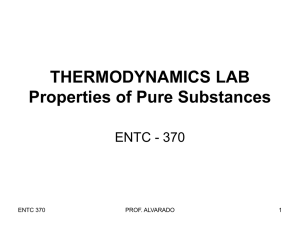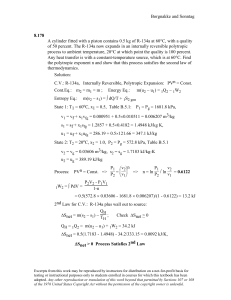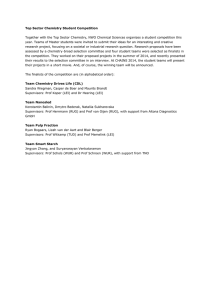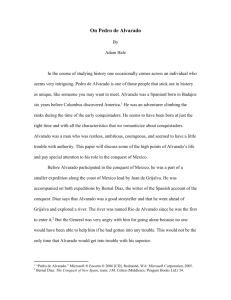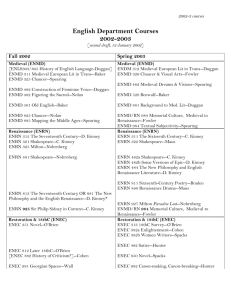Polytropic Process(1)
advertisement
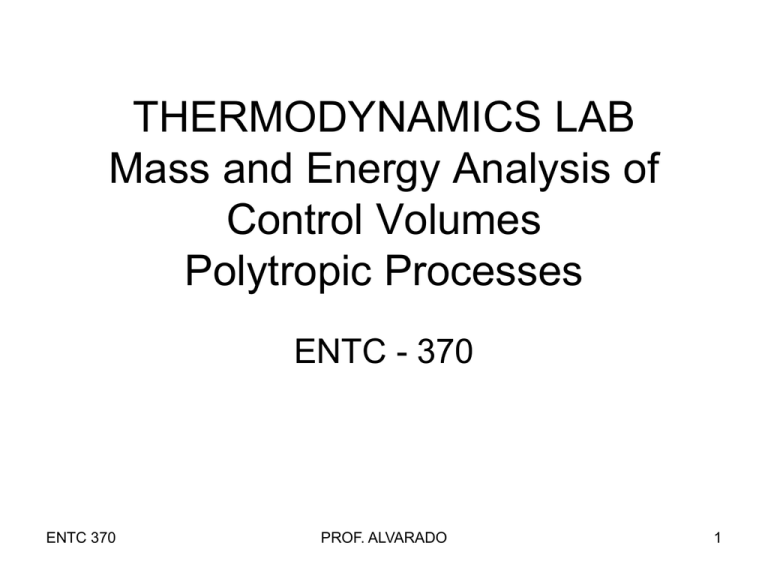
THERMODYNAMICS LAB Mass and Energy Analysis of Control Volumes Polytropic Processes ENTC - 370 ENTC 370 PROF. ALVARADO 1 Polytropic Process(1) • During expansion and compression processes of gases, the following relationship holds: PV n = C1 If m is constant, m n is also constant Vn P n = C2 m Pv n = C2 Equation_ 1 For a Process from state 1 to state 2: P1v1n = P2 v2n • The coefficient n depends on the process. 2 Polytropic Process(2) • During expansion and compression processes of gases, the following relationship holds: Taking natural log_ of_ Equation_ 1: ln(P) n ln( v ) C Y ln(P); X ln( v ) Y -n X C If we measure T and P, we can_ obtain_ PV mRT V m RT P v v_ from_ Ideal_ gas_ equation RT P • The coefficient n depends on the process. 3 : Polytropic Process • The coefficient n depends on the process: ― n=0 , Isobaric process (constant pressure) 5-1 in graph. ― n=∞, Isometric process (constant volume) 2-6 in graph. ― n=1, Isothermal process (constant temperature) 4-8 in graph. ― n=k, Adiabatic process (no heat transfer) 3-7 in the graph. k=cp/cv=1.4 for air. Graph from www.taftan.com ENTC 370 PROF. ALVARADO 4 Polytropic Process • Boundary work: Wb m R (T 2 T1 ) 1 n V2 W b P V ln V1 ENTC 370 n 1 n= 1 PROF. ALVARADO 5 Problem 1: Polytropic Process (Excel) - Pressurized air inside a pressure vessel is expanded in a polytropic process using three discharge valves with small, medium and large orifices. The measured temperature and pressure for the process are posted. 1. Use the ideal gas law, Pv = RT, to compute v for each corresponding P. Use SI units: m3/kg for v, kPa for P and ºK for T. Conversion factor: 6.894 kPa=1 PSI ºK = ºC+273.15 R= 0.286 KJ/(kg ºK) for air 2. Plot ln(P) versus ln(v) and find n: a. For each run, on a separate graph, plot ln(P) [on the ordinate (vertical) axis] versus ln(v) [on the abscissa (horizontal) axis]. b. Determine the polytropic exponent n by using a linear model of each run. Also find the correlation coefficient R2. 3. Discuss the meaning of your n values, that is, how do the n values compare with n values for other, known processes (see previous slide)? ENTC 370 PROF. ALVARADO 6 Turbines and Compressors • Analysis for steady state systems, Energy balance: For Adiabatic Turbines : E in E out v1 2 2 v2 m ( h1 gz 1 ) W out m ( h 2 gz 2 ) 2 2 ke v v 2 1 2 2 2 ENTC 370 PROF. ALVARADO 7 Problem 2: Steam Turbine (EES) Steam flows steadily (8 kg/sec, mass flow rate) through an adiabatic turbine. The inlet conditions of the steam are 10 MPa, 350 ºC, and 65 m/sec. The exit conditions are 85% quality, and 40 m/sec. The exit pressure varies from 10 kPa to 200 kPa. P1,T1,V1 Determine: -Change in Kinetic Energy (ke) -Turbine inlet area P2,x2,V2 -Plot the power output against the outlet pressure ENTC 370 PROF. ALVARADO 8 Problem 2: Steam Turbine (EES) m V vA where , m mass _ flow _ rate V Volume _ flow _ rate v velocity specific _ volume A cross _ sec tional _ area ENTC 370 PROF. ALVARADO 9 Individual Lab Report • Introduction: Briefly explain the objectives of the assigned tasks • Data: Present data in tabulated form (use Excel) • Findings or Results: Include plots (EES and Excel) for each data set and the corresponding correlation equations and correlation values • Conclusions: Comment on the tasks performed and provide concluding remarks ENTC 370 PROF. ALVARADO 10
